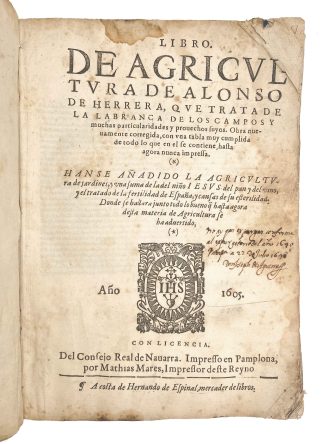HERRERA, Gabriel Alonso de.
Libro de agricultura
Pamplona, por Matías Mares a costa de Fernando de Espinal, 1605£1,850.00
Large 4to. ff. (iv + 1 added leaf of errata) 242. Roman letter, little Italic. Woodcut vignette to t-p, decorated initials and headpieces. Light waterstaining to first three gatherings, occasionally to margins throughout, outer margin of t-p dust-soiled and a bit frayed, intermittent mainly marginal foxing, slight browning in places, clean tear with no loss to blank lower margin of fol. 21, small worm trail to blank outer margin of few gatherings, another to text touching a few letters, scattered ink spots, little thumbing, part of one column of text repaired and partially supplied in a contemporary hand to p. 127, slight offsetting to p. 228, clean cuts with no loss along gutter to last leaf. A good copy in contemporary vellum, traces of ties, ‘Períbañez’ inked to upper cover. Stamp of Rothamsted Research Centre to fep, inquisitorial inscription ‘no ay que expurgar conforme al expurgatorio del anno 1640. Pamp[lona] a 22 de Julio 1642(?). Don Joseph de Aguerre’, some early annotation.
Very scarce edition of this extremely successful and ground-breaking manual of agriculture in Castilian. Gabriel Alonso de Herrera (1470-1539) was a Franciscan agronomist and brother to the humanist Hernando and the musician Diego Alonso de Herrera. He is most renowned for this ‘Libro de agricultura’, first printed in Spain in 1513, which underwent over 20 editions in just a few decades and was translated into Latin, Italian and French. It was a compilation based on a variety of agricultural and medical sources, including Greek (Galen and Hippocrates), Arabic (Avenzoar and Avicenna), and Latin ‘De re rustica’ authors (Columella, Cato, Varro and Palladius). Following the classical tradition, Herrera presented a holistic view of the agronomist as knowledgeable in the cultivation of crops and trees, techniques for making soil and water suitable for agriculture and horticulture, the forecast of adverse weather conditions, farming and herbal medical remedies. He also injected into this solid tradition new ideas—based on contemporary agricultural theories and his own experience—concerning the identification of high-quality seed which should be grown separately from the rest to improve the quality of crops, as well as plant reproductive morphology, i.e., he believed that plants could be masculine or feminine. Juan de Valverde’s ‘Despertador’ and Gutiérrez Salinas’s ‘Discursos’ similarly deal with agricultural and horticultural techniques; the first also discusses farming and the use of beasts of burden as well as the remedies to preserve one’s estate in times of famine and inclement weather.
The printer, Matías Mares, intended this text to be bound with Juan de Valverde’s ‘Despertador’, Diego Gutiérrez Salinas’s ‘Discursos del pan y del vino del Niño Jesús’—originally printed in Alcalá de Henares in 1600 and here summarised—and Gregorio de los Rios’s ‘Agricultura de jardines’ printed in Zaragoza in 1604. This copy contains the 4 ll. of preliminaries (plus an additional leaf of errata) and 242 ll. of text which encompass the (complete) works by Herrera, Valverde and Salinas. The separately printed 6 ll. containing de los Rios’s work were not bound in this copy, as Palau, see below.
José de Aguirre SJ was an Inquisitor whose ‘expurgatorio’ dating from the 1640s is recorded in other Spanish books. He authored the pamphlet ‘Profecía de Santa Hildegardis’.
Only Columbia, WSU and LC copies recorded in the US.Brunet III, 131; Graesse III, 260; Wilkinson, Iberian Books 20625; Palau 114100; Pritzel, Thesaurus Literaturae Botanicae, 4411. Not in Oberlé or Bitting.In stock





